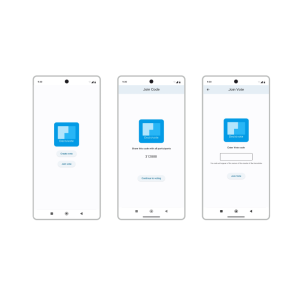2023
Decisivote
This project was developed as part of the course Mobile Computing: Design and Implementation, an academic group project in Interaction Design.
ROLE: Developer, Researcher, Designer
PROJECT DURATION: Sep. 2023 - Oct. 2023 (7.5 hp)

Project Overview
Decisivote is a communication tool designed to facilitate collaborative decision-making. It offers users various structured voting methods, allowing for pre-defined options while also supporting the dynamic addition of suggestions from participants. The app’s unique approach lies in its voting process, which draws inspiration from established decision-making techniques.
Users evaluate options one by one (e.g., rating them as good or bad), depending on the type of vote. After voting, participants are brought to a shared page to discuss the results, fostering collaboration and consensus-building. The app combines usability and structure to simplify decision-making in group settings.
My Roles and Contributions
I contributed to Decisivote as a developer, researcher, and designer, taking on multiple roles throughout the project. Alongside another student, I was responsible for both the visual design and functionality of the app. We started by creating interactive mockups in Figma to validate usability and align the design with user expectations. These designs were then translated into a functional product using Flutter and Dart, with Firebase as the backend to support dynamic voting and real-time updates.
My prior experience with Java and programming overall made it easier for me to quickly learn Dart, allowing me to take an active role in coding the app’s core features and debugging implementation issues. This adaptability ensured that I could tackle technical challenges effectively and contribute significantly to the project’s success.
My key responsibilities included:
Ideation & Research: Conducted brainstorming sessions and problem definition to explore user needs and decision-making behaviors.
Wireframing & Prototyping: Designed mockups in Figma and translated them into Flutter, ensuring a seamless transition from concept to implementation.
Development: Built core functionality, including dynamic voting processes and real-time collaboration features, ensuring technical feasibility.
Usability Testing: Conducted user testing to refine functionality and address pain points, ensuring the app was intuitive and user-friendly.
Problem Solving & Analysis: Collaborated with team members to troubleshoot implementation challenges, ensuring the voting process met design and technical requirements.
Design Process
We followed a lean UX design thinking process to ensure that the product aligned with the course’s collaboration theme and delivered a usable, functional experience.
01. Define
Problem Statement: How might we create a collaborative tool that simplifies group decision-making while supporting diverse voting methods?
02. Ideation
Brainstorming: Held collaborative sessions to generate ideas for intuitive decision-making features.
Dot Voting: Used dot voting to prioritize features that best addressed the problem statement
03. Prototyping
Wireframing: Created low-fidelity wireframes in Figma to visualize core user flows and interactions.
Prototyping & Mockups: Designed high-fidelity mockups in Figma, refining user flows based on usability feedback
04. Implementation
We developed the app using Flutter and Dart, integrating Firebase for backend support. This ensured real-time updates and a seamless voting experience.
05. Testing
Conducted user testing to validate the app’s usability and collaboration features, gathering feedback for iterative improvements.
Challenges and Solutions
Dynamic Voting Process:
One challenge was integrating dynamic voting options while maintaining an intuitive experience. To address this, we used iterative prototyping and testing to refine the flow, ensuring that users could easily add suggestions and evaluate options without confusion.
Design Feedback:
While the functionality and programming were the primary focus of the project, some users expressed a desire for a more polished, high-end visual design. Given the project’s emphasis on backend development and core functionality, we prioritized usability and collaboration features over aesthetic refinement. This feedback highlighted the importance of balancing technical and visual aspects in future iterations.
Technical Limitations:
Developing real-time collaboration features with Firebase presented backend challenges. By adopting Agile principles and dividing tasks into manageable sprints, we were able to troubleshoot issues effectively and ensure a functional implementation.
Impact and Results
Decisivote received positive feedback for its engaging and structured approach to group decision-making. Testing sessions revealed that users appreciated the app’s ease of use and its focus on facilitating collaboration. The combination of iterative design and lean development allowed us to deliver a functional product within the course timeline while staying aligned with the theme of collaboration.